Selection of Natural Fibre for Pultruded Hybrid Synthetic/Natural Fibre Reinforced Polymer Composites Using Analytical Hierarchy Process for Structural Applications
Abstract
:1. Introduction
2. Design Framework and Criteria
2.1. Pultruded FRP Composites for Structural Application
2.2. Criteria in the Selection of Natural Fibre for Pultruded Structural Application
2.2.1. Tensile Strength
2.2.2. Tensile Modulus
2.2.3. Density
2.2.4. Elongation at Break
2.2.5. Cellulose Content
2.2.6. Local Availability
| Fibres | Tensile Strength (MPa) | Tensile Modulus (GPa) | Density (g/cm3) | Elongation (%) | Cellulose Content (%) | References |
|---|---|---|---|---|---|---|
| Bagasse | 20–290 | 19.7–27.1 | 1.2 | 1.1 | 52.4 | [57,58] |
| Bamboo | 230–295 | 17 | 1.1 | 11 | 54.6 | [58,59,60,61] |
| Banana | 355 | 33.8 | 1.35 | 5.3 | 65 | [57] |
| Coir | 220 | 6 | 1.25 | 15–25 | 43 | [57] |
| Cotton | 400 | 12 | 1.51 | 3–10 | 82.7 | [57] |
| Flax | 500–1500 | 60–80 | 1.4 | 1.2–1.6 | 64.1 | [57] |
| Hemp | 550–900 | 70 | 1.48 | 1.6 | 74.4 | [57] |
| Jute | 400–800 | 10–30 | 1.46 | 1.8 | 64.4 | [57] |
| Kenaf | 930 | 53 | 1.2 | 2.7–6.9 | 53.4 | [57] |
| Oil Palm | 248 | 3.2 | 1.55 | 2.5 | 65 | [57] |
| Pineapple leaf (PALF) | 170–1627 | 53 | 1.5 | 1–3 | 70 | [57,62] |
| Ramie | 500 | 44 | 1.5 | 2 | 68.6 | [57] |
| Sisal | 600–700 | 38 | 1.33 | 2–3 | 65.8 | [57] |
| E-glass | 2000–3500 | 70 | 2.5 | 2.8 | - | [63] |
3. AHP Methodology
3.1. Hierarchical Structure
3.2. Pairwise Comparison Using Relative Intensity Scale Value
- Calculation of Eigen vectors
3.3. Consistency Ratio
- Calculation of Principal Eigen Value (λmax)
- Calculation of Consistency index
- Calculation of Consistency ratio
3.4. Formulating and Synthesizing PCM of the Proposed Materials with Respect to Criteria
3.5. Identifying the Best Alternative According to Global Prioritization
4. Pairwise Comparison Matrix (PCM) Using AHP Software
5. Results and Discussion
6. Conclusions
- Kenaf fibre is selected as the suitable alternative using AHP analysis, satisfying the basic design objectives and criteria of the application intended.
- Consistency analysis was performed to validate the judgements made in the development of PCM. The overall inconsistency ratio obtained was 0.01, which is lower than the maximum CR value (0.1). Hence, it is proven that the judgements made during the AHP analysis were consistent and valid.
- The sensitivity analysis shows that kenaf fibre is the best alternative as it scored the highest priority vector in four out of six criteria (tensile strength, density, cellulose, and availability). This further validates the fibre selection process using AHP.
- Overall, the AHP method serves researchers and engineers as one of the effective multi-criteria decision-making tools to perform selection and problem-solving tasks systematically for various applications. There is still a huge scope of work to optimally select the suitable natural fibres for other various practical engineering applications where AHP can be used as a tool in various research areas. Additionally, pultruded kenaf/glass reinforced hybrid composites can be further analysed for its mechanical, physical, and structural performance to identify and validate its integrity in practical engineering structural applications.
Author Contributions
Funding
Institutional Review Board Statement
Informed Consent Statement
Data Availability Statement
Acknowledgments
Conflicts of Interest
References
- Balasubramanian, K.; Sultan, M.T.H.; Rajeswari, N. Manufacturing Techniques of Composites for Aerospace Applications. In Sustainable Composites for Aerospace Applications; Woodhead Publishing: Sawston, UK, 2018; pp. 55–67. [Google Scholar]
- Rajak, D.K.; Pagar, D.D.; Kumar, R.; Pruncu, C.I. Recent Progress of Reinforcement Materials: A Comprehensive Overview of Composite Materials. J. Mater. Res. Technol. 2019, 8, 6354–6374. [Google Scholar] [CrossRef]
- Brandt Goldsworthy: Composites Visionary. Composites World. Available online: https://www.compositesworld.com/articles/brandt-goldsworthy-composites-visionary (accessed on 30 May 2022).
- Advanced Fibre-Reinforced Polymer (FRP) Composites for Structural Applications. Available online: https://books.google.com.my/books?id=7ZV1DAAAQBAJ&printsec=frontcover&dq=pultrusion&hl=en&sa=X&redir_esc=y#v=onepage&q=pultrusion&f=false (accessed on 11 March 2022).
- Minchenkov, K.; Vedernikov, A.; Safonov, A.; Akhatov, I. Thermoplastic Pultrusion: A Review. Polymers 2021, 13, 180. [Google Scholar] [CrossRef] [PubMed]
- Nunna, S.; Chandra, P.R.; Shrivastava, S.; Jalan, A.K. A Review on Mechanical Behavior of Natural Fiber Based Hybrid Composites. J. Reinf. Plast. Compos. 2012, 31, 759–769. [Google Scholar] [CrossRef]
- Sanjay, M.R.; Arpitha, G.R.; Yogesha, B. Study on Mechanical Properties of Natural-Glass Fibre Reinforced Polymer Hybrid Composites: A Review. Mater. Today Proc. 2015, 2, 2959–2967. [Google Scholar] [CrossRef]
- Chandrasekar, M.; Ishak, M.R.; Sapuan, S.M.; Leman, Z.; Jawaid, M. A Review on the Characterisation of Natural Fibres and Their Composites after Alkali Treatment and Water Absorption. Plast. Rubber Compos. 2017, 46, 119–136. [Google Scholar] [CrossRef]
- Alomayri, T.; Assaedi, H.; Shaikh, F.U.A.; Low, I.M. Effect of Water Absorption on the Mechanical Properties of Cotton Fabric-Reinforced Geopolymer Composites. J. Asian Ceram. Soc. 2014, 2, 223–230. [Google Scholar] [CrossRef] [Green Version]
- Barouni, A.; Lupton, C.; Jiang, C.; Saifullah, A.; Giasin, K.; Zhang, Z.; Dhakal, H.N. Investigation into the Fatigue Properties of Flax Fibre Epoxy Composites and Hybrid Composites Based on Flax and Glass Fibres. Compos. Struct. 2022, 281, 115046. [Google Scholar] [CrossRef]
- Sushma Chinta, V.; Ravinder Reddy, P.; Eshwar Prasad, K. Experimental Investigation of High Cycle Fatigue Life of Jute Fibre Reinforced Hybrid Composite Material for Axial Flow Fan Blades. Mater. Today Proc. 2022, 59, 357–367. [Google Scholar] [CrossRef]
- Thwe, M.M.; Liao, K. Effects of Environmental Aging on the Mechanical Properties of Bamboo–Glass Fiber Reinforced Polymer Matrix Hybrid Composites. Compos. Part A Appl. Sci. Manuf. 2002, 33, 43–52. [Google Scholar] [CrossRef]
- Abbasi, A.; Hogg, P.J. Temperature and Environmental Effects on Glass Fibre Rebar: Modulus, Strength and Interfacial Bond Strength with Concrete. Compos. Part B Eng. 2005, 36, 394–404. [Google Scholar] [CrossRef]
- Amaro, A.M.; Reis, P.N.B.; Neto, M.A.; Louro, C. Effects of Alkaline and Acid Solutions on Glass/Epoxy Composites. Polym. Degrad. Stab. 2013, 98, 853–862. [Google Scholar] [CrossRef]
- Phani, K.K.; Bose, N.R. Hydrothermal Ageing of Jute-Glass Fibre Hybrid Composites-an Acousto-Ultrasonic Study. J. Mater. Sci. 1987, 22, 1929–1933. [Google Scholar] [CrossRef]
- Padanattil, A.; Jayanarayanan, K.; Mini, K.M. Novel Hybrid Composites Based on Glass and Sisal Fiber for Retrofitting of Reinforced Concrete Structures. Constr. Build. Mater. 2017, 133, 146–153. [Google Scholar] [CrossRef]
- Mayandi, K.; Rajini, N.; Manojprabhakar, M.; Siengchin, S.; Ayrilmis, N. Recent Studies on Durability of Natural/Synthetic Fiber Reinforced Hybrid Polymer Composites. In Durability and Life Prediction in Biocomposites, Fibre-Reinforced Composites and Hybrid Composites; Woodhead Publishing: Sawston, UK, 2019; pp. 1–13. [Google Scholar]
- Naga Kumar, C.; Prabhakar, M.N.; Song, J.I. Effect of Interface in Hybrid Reinforcement of Flax/Glass on Mechanical Properties of Vinyl Ester Composites. Polym. Test. 2019, 73, 404–411. [Google Scholar] [CrossRef]
- Hybrid Natural Fiber Composites: Material Formulations, Processing, Characterization, Properties, and Engineering Applications. Available online: https://books.google.com.my/books/about/Hybrid_Natural_Fiber_Composites.html?id=FKDgDwAAQBAJ&printsec=frontcover&source=kp_read_button&hl=en&redir_esc=y#v=onepage&q&f=false (accessed on 11 March 2022).
- Mahalingam, J. Mechanical, Thermal, and Water Absorption Properties of Hybrid Short Coconut Tree Primary Flower Leaf Stalk Fiber/Glass Fiber-Reinforced Unsaturated Polyester Composites for Biomedical Applications. Biomass Convers. Biorefinery 2022, 1–12. [Google Scholar] [CrossRef]
- Adesina, O.T.; Jamiru, T.; Sadiku, E.R.; Ogunbiyi, O.F.; Beneke, L.W. Mechanical Evaluation of Hybrid Natural Fibre–Reinforced Polymeric Composites for Automotive Bumper Beam: A Review. Int. J. Adv. Manuf. Technol. 2019, 103, 1781–1797. [Google Scholar] [CrossRef]
- Ilyas, R.A.; Sapuan, S.M.; Norizan, M.N.; Atikah, M.S.N.; Huzaifah, M.R.M.; Radzi, A.M.; Ishak, M.R.; Zainudin, E.S.; Izwan, S.; Azammi, A.N.; et al. Potential of natural fibre composites for transport industry: A review development and characterization of sugar palm nanocellulose fibre reinforced sugar palm starch biopolymer composite view project fiber reinforced polymer nanocomposites view project. In Prosiding Seminar Enau Kebangsaan; Persatuan Pembangunan dan Industri Enau Malaysia (PPIEM): Bahau, Malaysia, 2019. [Google Scholar]
- Huda, M.K.; Widiastuti, I. Natural Fiber Reinforced Polymer in Automotive Application: A Systematic Literature Review. J. Phys. Conf. Ser. 2021, 1808, 12015. [Google Scholar] [CrossRef]
- Yu, D.; Kou, G.; Xu, Z.; Shi, S. Analysis of Collaboration Evolution in AHP Research: 1982–2018. Int. J. Inf. Technol. Decis. Mak. 2021, 20, 7–36. [Google Scholar] [CrossRef]
- Darko, A.; Chan, A.P.C.; Ameyaw, E.E.; Owusu, E.K.; Pärn, E.; Edwards, D.J. Review of Application of Analytic Hierarchy Process (AHP) in Construction. Int. J. Constr. Manag. 2018, 19, 436–452. [Google Scholar] [CrossRef]
- Dweiri, F.; Al-Oqla, P.M. Material Selection Using Analytical Hierarchy Process. Int. J. Comput. Appl. Technol. 2006, 26, 182–189. [Google Scholar] [CrossRef]
- Naveen, J.; Jawaid, M.; Zainudin, E.S.; Sultan, M.T.H.; Yahaya, R.B. Selection of Natural Fiber for Hybrid Kevlar/Natural Fiber Reinforced Polymer Composites for Personal Body Armor by Using Analytical Hierarchy Process. Front. Mater. 2018, 5, 52. [Google Scholar] [CrossRef]
- Sapuan, S.M.; Kho, J.Y.; Zainudin, S.; Leman, Z.; Ali, A.; Hambali, A. Materials Selection for Natural Fiber Reinforced Polymer Composites Using Analytical Hierarchy Process. Indian, J. Eng. Mater. Sci. 2011, 18, 255–267. [Google Scholar]
- Ishizaka, A.; Labib, A. Analytic Hierarchy Process and Expert Choice: Benefits and Limitations. OR Insight 2009, 22, 201–220. [Google Scholar] [CrossRef] [Green Version]
- Olson, D.L. Opportunities and Limitations of AHP in Multiobjective Programming. Math. Comput. Model. 1988, 11, 206–209. [Google Scholar] [CrossRef]
- Assistant, R. Why fuzzy analytic hierarchy process approach for transport problems? senay oğuztimur. In Proceedings of the 51st Congress of the European Regional Science Association: “New Challenges for European Regions and Urban Areas in a Globalised World”, Barcelona, Spain, 30 August–3 September 2011. [Google Scholar]
- Karthikeyan, R.; Venkatesan, K.G.S.; Chandrasekar, A. A Comparison of Strengths and Weaknesses for Analytical Hierarchy Process. J. Chem. Pharm. Sci. 2016, 9, 12–15. [Google Scholar]
- Pultrusion: State-of-the-Art Process Models-Ismet Baran-Google Books. Available online: https://books.google.com.my/books?hl=en&lr=&id=EwBNDwAAQBAJ&oi=fnd&pg=PR3&dq=books+pultrusion&ots=pWno7FBJiD&sig=BWOVNIOapCWlbE2F9JNA6lOGahw&redir_esc=y#v=onepage&q=books%20pultrusion&f=false (accessed on 10 March 2022).
- Pultrusion for Engineers-Google Books. Available online: https://books.google.com.my/books?hl=en&lr=&id=V7OjAgAAQBAJ&oi=fnd&pg=PP1&dq=books+pultrusion&ots=4zSG4yLxIg&sig=xcgiAFACbXt5uEK-Fpggy_xIB7k&redir_esc=y#v=onepage&q=books%20pultrusion&f=false (accessed on 10 March 2022).
- Handbook of Pultrusion Technology-Raymond Meyer-Google Books. Available online: https://books.google.com.my/books?hl=en&lr=&id=HY8kBAAAQBAJ&oi=fnd&pg=PA1&dq=books+pultrusion&ots=jLHjBeIgnB&sig=nUvEsgGdNJuHb_35TeOLRqnlMUg&redir_esc=y#v=onepage&q=books%20pultrusion&f=false (accessed on 10 March 2022).
- EPTA Industry Briefing: Pultruded Composites in Infrastructure–EPTA. Available online: https://pultruders.com/opportunities-for-pultruded-composites-in-infrastructure/ (accessed on 26 March 2022).
- EPTA Industry Briefing: Pultruded Composites in Energy Efficient Buildings—EPTA. Available online: https://pultruders.com/epta-industry-briefing/ (accessed on 26 March 2022).
- Top FRP Manufacturer and Supplier in Malaysia-Mui Fatt Marketing Sdn Bhd. Available online: https://www.muifatt.com.my/ (accessed on 26 March 2022).
- Angelov, I.; Wiedmer, S.; Evstatiev, M.; Friedrich, K.; Mennig, G. Pultrusion of a Flax/Polypropylene Yarn. Compos. Part A Appl. Sci. Manuf. 2007, 38, 1431–1438. [Google Scholar] [CrossRef]
- Linganiso, L.Z.; Bezerra, R.; Bhat, S.; John, M.; Braeuning, R.; Anandjiwala, R.D. Pultrusion of Flax/Poly(Lactic Acid) Commingled Yarns and Nonwoven Fabrics. J. Thermoplast. Compos. Mater. 2013, 27, 1553–1572. [Google Scholar] [CrossRef]
- Fairuz, A.M.; Sapuan, S.M.; Zainudin, E.S.; Jaafar, C.N.A. Optimization of Pultrusion Process for Kenaf Fibre Reinforced Vinyl Ester Composites. Appl. Mech. Mater. 2015, 761, 499–503. [Google Scholar] [CrossRef]
- Omar, M.F.; Md Akil, H.; Ahmad, Z.A.; Mazuki, A.A.M.; Yokoyama, T. Dynamic Properties of Pultruded Natural Fibre Reinforced Composites Using Split Hopkinson Pressure Bar Technique. Mater. Des. 2010, 31, 4209–4218. [Google Scholar] [CrossRef]
- Peng, X.; Fan, M.; Hartley, J.; Al-Zubaidy, M. Properties of Natural Fiber Composites Made by Pultrusion Process. J. Compos. Mater. 2012, 46, 237–246. [Google Scholar] [CrossRef]
- Fairuz, A.M.; Sapuan, S.M.; Zainudin, E.S.; Jaafar, C.N.A. Pultrusion Process of Natural Fibre-Reinforced Polymer Composites. In Manufacturing of Natural Fibre Reinforced Polymer Composites; Springer: Cham, Switzerland, 2015; pp. 217–231. [Google Scholar] [CrossRef] [Green Version]
- Zakaria, K.Z.; Akil, H.M.; Shamsuddin, M.S.M.; Ishak, Z.A.M. Mechanical Performance of Pultruded Kenaf/Glass Hybrid Fiber Reinforced Unsaturated Polyester under Hygrothermal Conditions. AIP Conf. Proc. 2020, 2267, 20045. [Google Scholar] [CrossRef]
- Akil, H.M.; de Rosa, I.M.; Santulli, C.; Sarasini, F. Flexural Behaviour of Pultruded Jute/Glass and Kenaf/Glass Hybrid Composites Monitored Using Acoustic Emission. Mater. Sci. Eng. A 2010, 527, 2942–2950. [Google Scholar] [CrossRef]
- Malek, F.H.A.; Zainudin, E.S.; Tahir, P.M.; Jawaid, M. The Effect of Additives on Bending Strenght of Pultruded Hybrid Reinforced Resol Type Phenolic Composite. Appl. Mech. Mater. 2014, 564, 418–421. [Google Scholar] [CrossRef]
- Mathangadeera, R.W.; Hequet, E.F.; Kelly, B.; Dever, J.K.; Kelly, C.M. Importance of Cotton Fiber Elongation in Fiber Processing. Ind. Crops Prod. 2020, 147, 112217. [Google Scholar] [CrossRef]
- Rahman, R.; Putra, S.Z.F.S. Tensile Properties of Natural and Synthetic Fiber-Reinforced Polymer Composites. In Mechanical and Physical Testing of Biocomposites, Fibre-Reinforced Composites and Hybrid Composites; Woodhead Publishing: Sawston, UK, 2019; pp. 81–102. [Google Scholar] [CrossRef]
- Tcharkhtchi, A.; Nony, F.; Khelladi, S.; Fitoussi, J.; Farzaneh, S. Epoxy/Amine Reactive Systems for Composites Materials and Their Thermomechanical Properties. In Advances in Composites Manufacturing and Process Design; Woodhead Publishing: Sawston, UK, 2015; pp. 269–296. [Google Scholar] [CrossRef]
- The Importance of Percent Elongation for Structural Castings-A&L Alluminio e Leghe. Available online: https://www.publiteconline.it/ael/the-importance-of-percent-elongation-for-structural-castings/ (accessed on 30 May 2022).
- Djafari Petroudy, S.R. Physical and Mechanical Properties of Natural Fibers. In Advanced High Strength Natural Fibre Composites in Construction; Woodhead Publishing: Sawston, UK, 2017; pp. 59–83. [Google Scholar] [CrossRef]
- Lu, N.; Swan, R.H.; Ferguson, I. Composition, Structure, and Mechanical Properties of Hemp Fiber Reinforced Composite with Recycled High-Density Polyethylene Matrix. J. Compos. Mater. 2012, 46, 1915–1924. [Google Scholar] [CrossRef]
- Sustainable Green Composites of Thermoplastic Starch and Cellulose Fibers. Available online: https://www.researchgate.net/publication/287296479_Sustainable_green_composites_of_thermoplastic_starch_and_cellulose_fibers (accessed on 25 April 2022).
- Ravindran, L.; Sreekala, M.S.; Thomas, S. Novel Processing Parameters for the Extraction of Cellulose Nanofibres (CNF) from Environmentally Benign Pineapple Leaf Fibres (PALF): Structure-Property Relationships. Int. J. Biol. Macromol. 2019, 131, 858–870. [Google Scholar] [CrossRef]
- Kim, D.Y.; Lee, B.M.; Koo, D.H.; Kang, P.H.; Jeun, J.P. Preparation of Nanocellulose from a Kenaf Core Using E-Beam Irradiation and Acid Hydrolysis. Cellulose 2016, 23, 3039–3049. [Google Scholar] [CrossRef]
- Jawaid, M.; Abdul Khalil, H.P.S. Cellulosic/Synthetic Fibre Reinforced Polymer Hybrid Composites: A Review. Carbohydr. Polym. 2011, 86, 1–18. [Google Scholar] [CrossRef]
- Recent Developments in Chemical Modification and Characterization of Natural Fiber-Reinforced. Available online: https://onlinelibrary.wiley.com/doi/abs/10.1002/pc.20461 (accessed on 27 May 2022).
- Abdul Khalil, H.P.S.; Bhat, I.U.H.; Jawaid, M.; Zaidon, A.; Hermawan, D.; Hadi, Y.S. Bamboo Fibre Reinforced Biocomposites: A Review. Mater. Des. 2012, 42, 353–368. [Google Scholar] [CrossRef]
- Javadian, A.; Smith, I.F.C.; Saeidi, N.; Hebel, D.E. Mechanical Properties of Bamboo through Measurement of Culm Physical Properties for Composite Fabrication of Structural Concrete Reinforcement. Front. Mater. 2019, 6, 15. [Google Scholar] [CrossRef]
- Shah, A.U.M.; Sultan, M.T.H.; Jawaid, M.; Cardona, F.; Talib, A.R.A. A Review on the Tensile Properties of Bamboo Fiber Reinforced Polymer Composites. BioResources 2016, 11, 10654–10676. [Google Scholar] [CrossRef] [Green Version]
- Todkar, S.S.; Patil, S.A. Review on Mechanical Properties Evaluation of Pineapple Leaf Fibre (PALF) Reinforced Polymer Composites. Compos. Part B Eng. 2019, 174, 106927. [Google Scholar] [CrossRef]
- Mansor, M.R.; Sapuan, S.M.; Zainudin, E.S.; Nuraini, A.A.; Hambali, A. Hybrid Natural and Glass Fibers Reinforced Polymer Composites Material Selection Using Analytical Hierarchy Process for Automotive Brake Lever Design. Mater. Des. 2013, 51, 484–492. [Google Scholar] [CrossRef]
- Hambali, A.; Sapuan, M.S.; Ismail, N.; Nukman, Y. Material Selection of Polymeric Composite Automotive Bumper Beam Using Analytical Hierarchy Process. J. Cent. South Univ. Technol. 2010, 17, 244–256. [Google Scholar] [CrossRef]
- Dos Santos, P.H.; Neves, S.M.; Sant’Anna, D.O.; de Oliveira, C.H.; Carvalho, H.D. The Analytic Hierarchy Process Supporting Decision Making for Sustainable Development: An Overview of Applications. J. Clean. Prod. 2019, 212, 119–138. [Google Scholar] [CrossRef]
- Yahaya, R.; Sapuan, S.M.; Leman, Z.; Zainudin, E.S. Selection of Natural Fibre for Hybrid Laminated Composites Vehicle Spall Liners Using Analytical Hierarchy Process (AHP). Appl. Mech. Mater. 2014, 564, 400–405. [Google Scholar] [CrossRef]
- Rashid, K.; Razzaq, A.; Ahmad, M.; Rashid, T.; Tariq, S. Experimental and Analytical Selection of Sustainable Recycled Concrete with Ceramic Waste Aggregate. Constr. Build. Mater. 2017, 154, 829–840. [Google Scholar] [CrossRef]

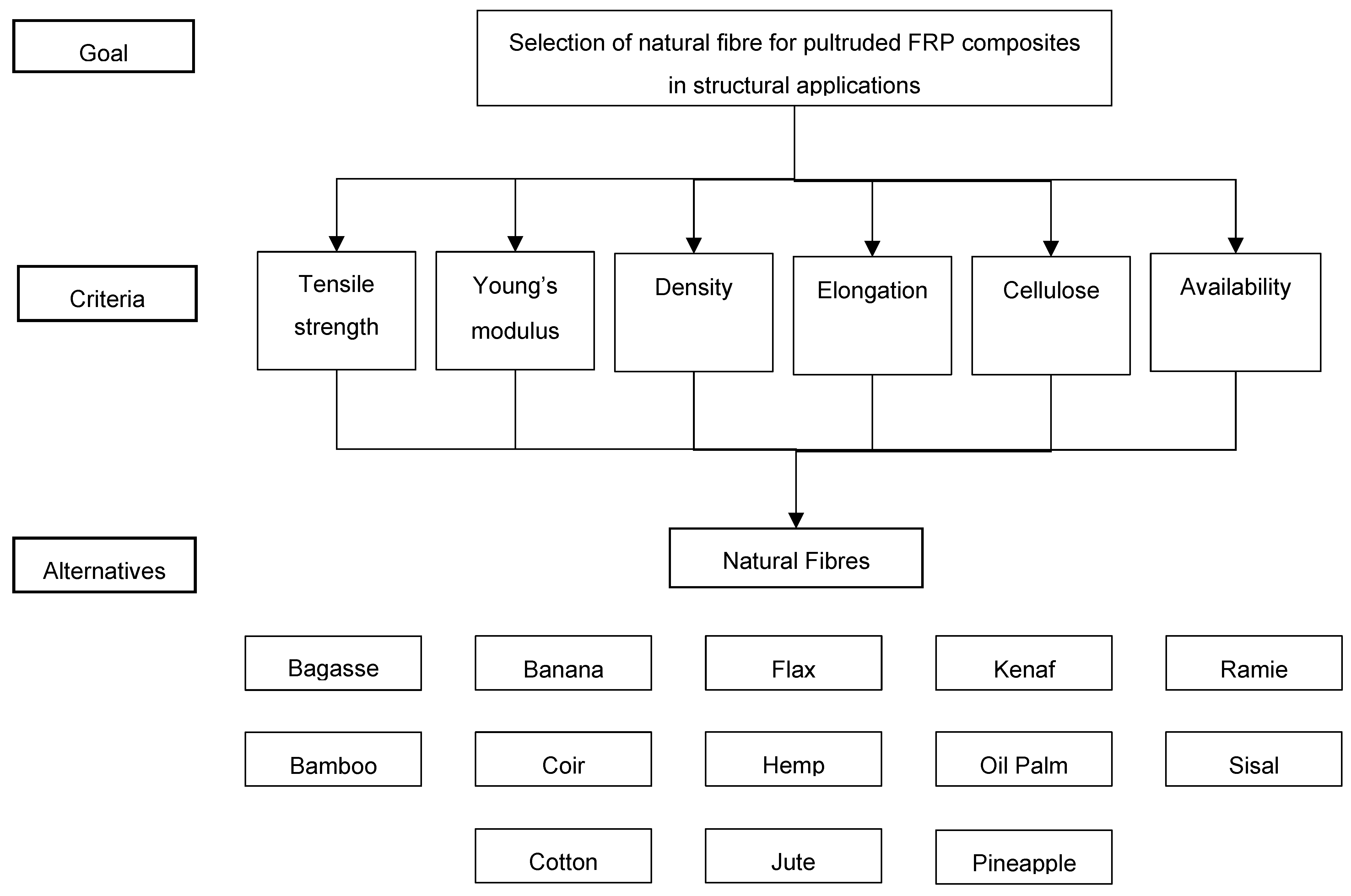


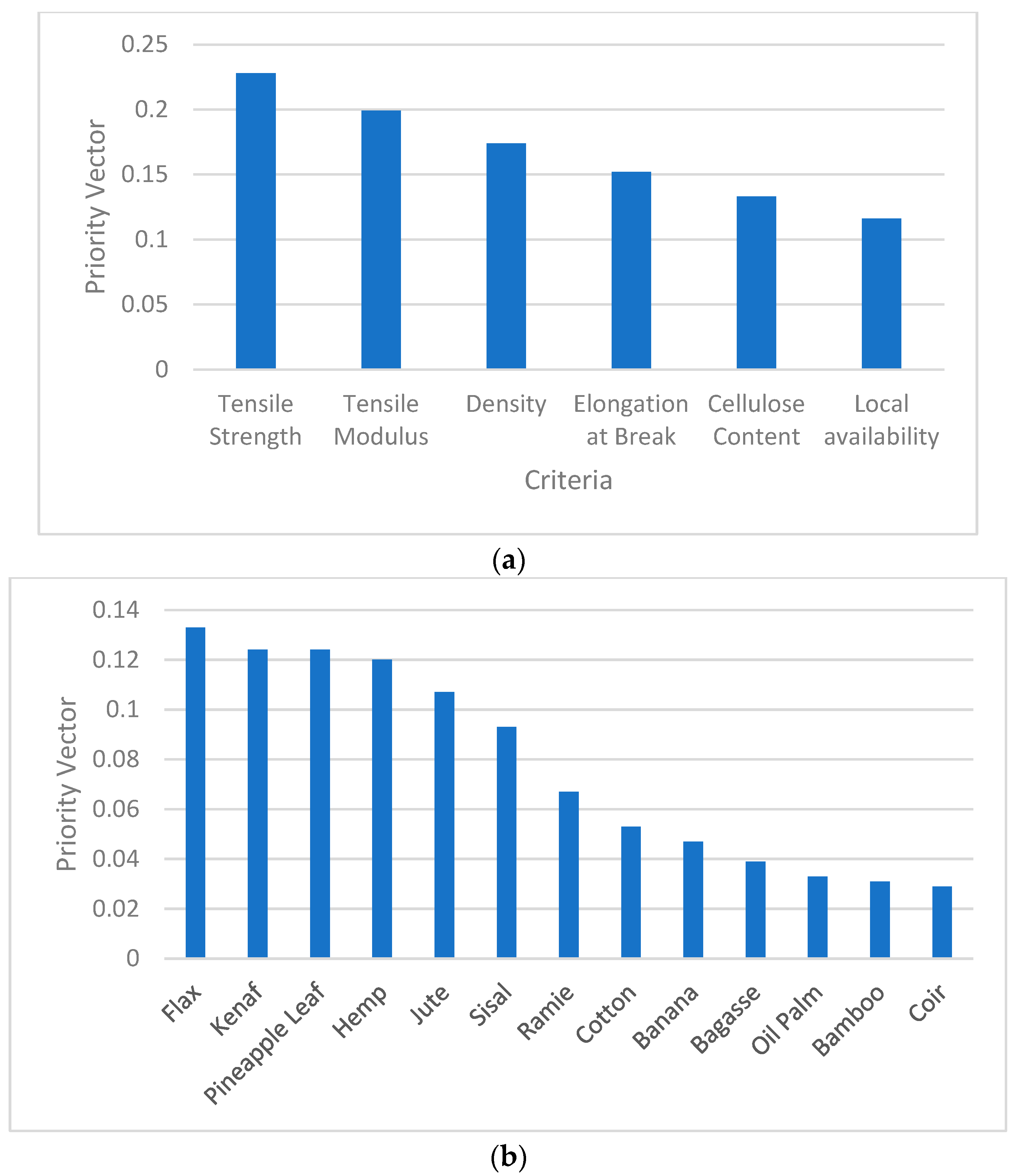

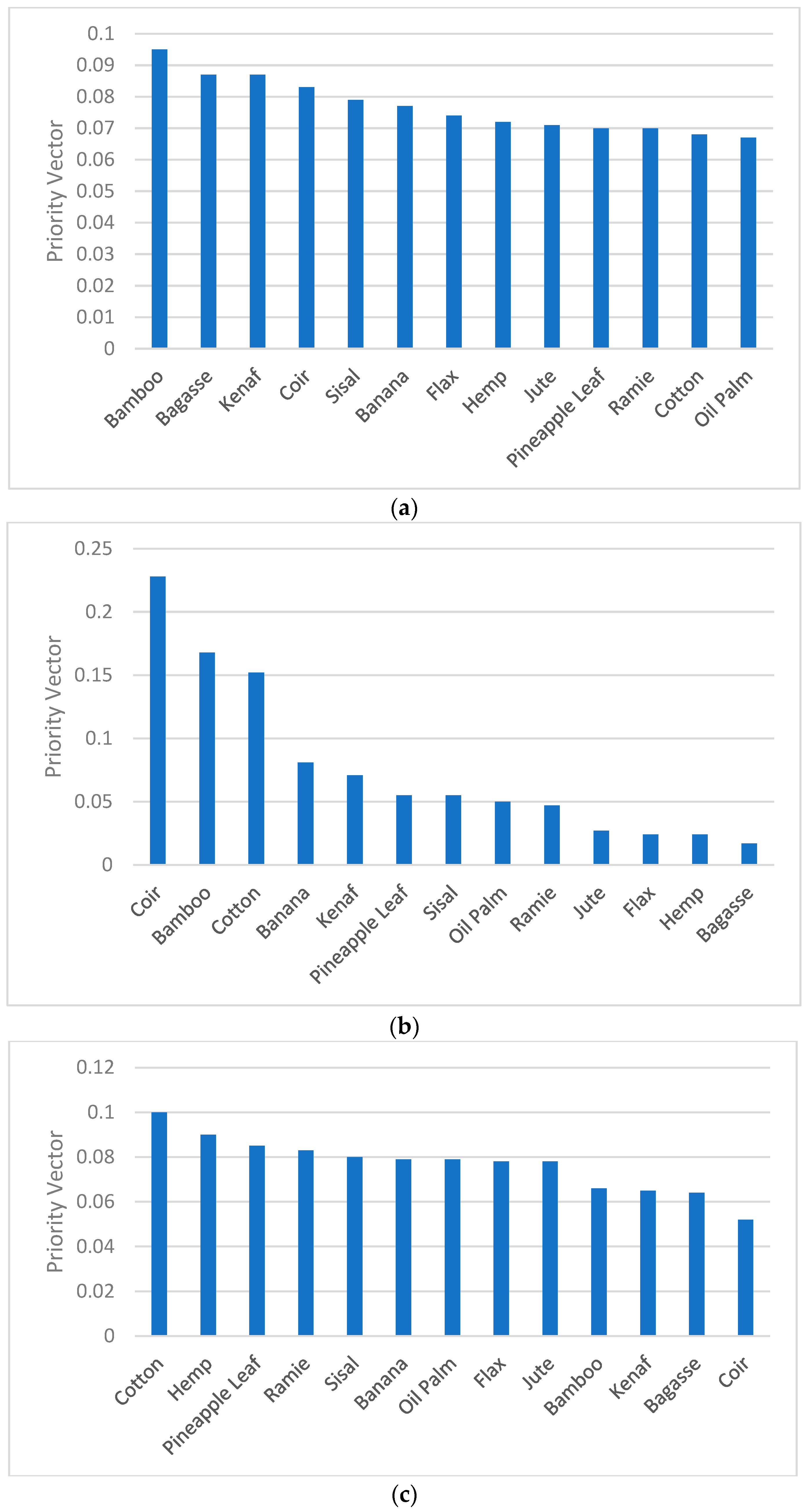
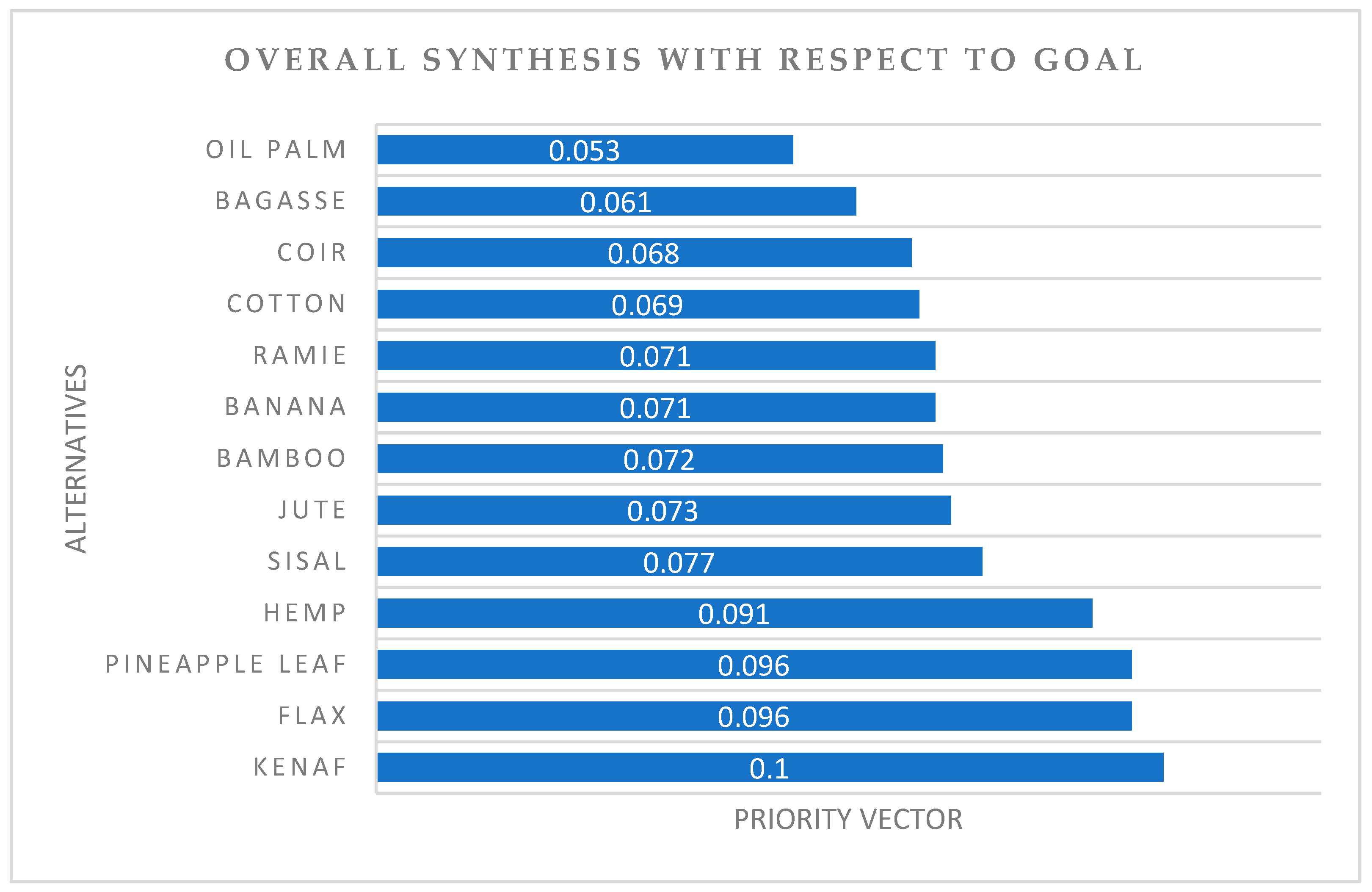

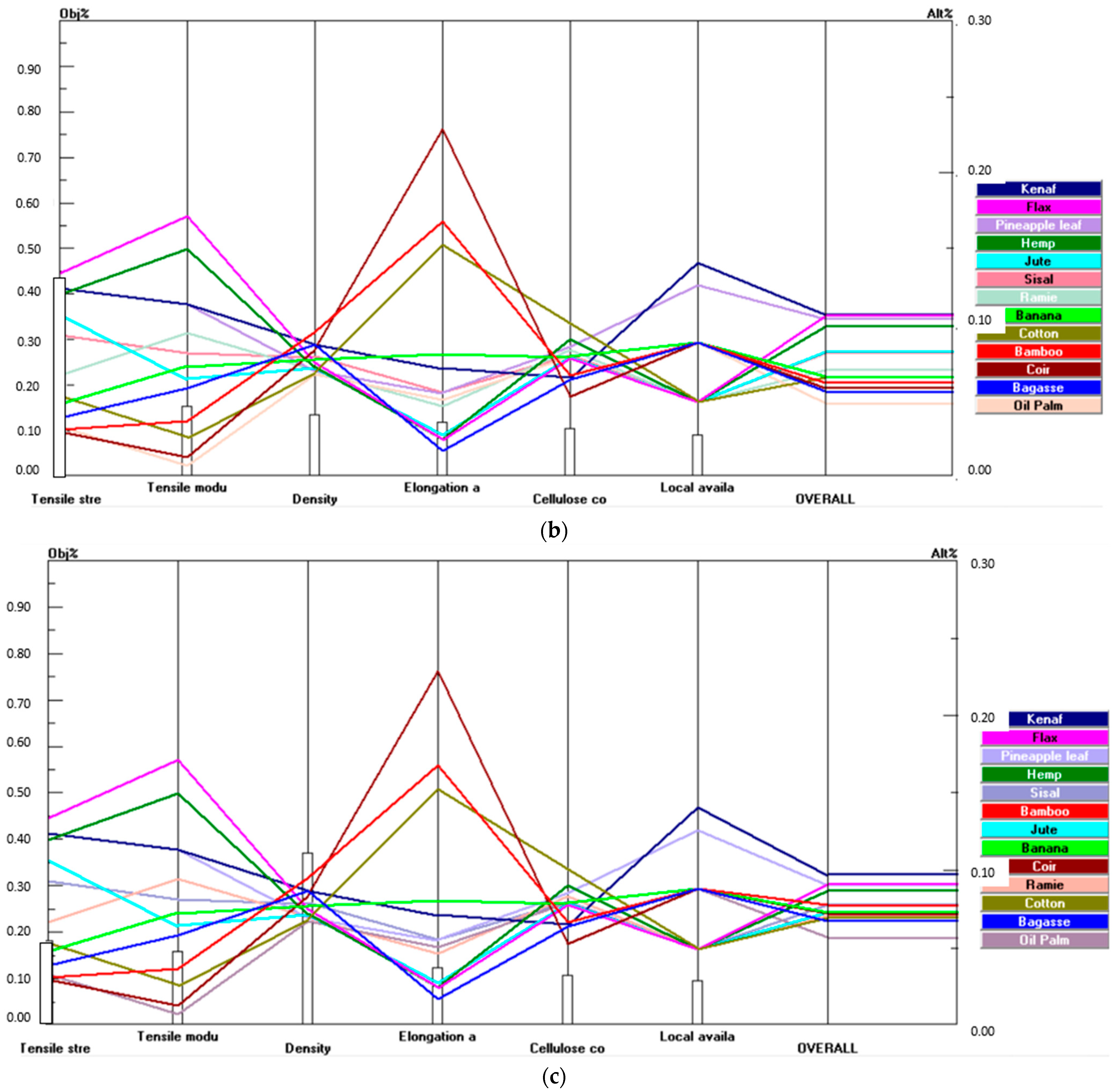
| Relative Intensity Scale | Definition |
|---|---|
| 1 | Equal importance of i and j |
| 3 | Slightly more importance of i over j |
| 5 | High importance of i over j |
| 7 | Very high importance of i over j |
| 9 | Extreme importance of i over j |
| 2, 4, 6, 8 | Intermediate values between two adjacent judgements |
| Size of Matrix | 1 | 2 | 3 | 4 | 5 | 6 | 7 | 8 | 9 | 10 |
|---|---|---|---|---|---|---|---|---|---|---|
| RI | 0 | 0 | 0.58 | 0.9 | 1.12 | 1.24 | 1.32 | 1.41 | 1.45 | 1.49 |
| Rank | Tensile Strength | Tensile Modulus | Density | Elongation | Cellulose | Availability |
|---|---|---|---|---|---|---|
| 1 | Kenaf | Flax | Kenaf | Coir | Kenaf | Kenaf |
| 2 | Flax | Hemp | Flax | Kenaf | Palf | Palf |
| 3 | Palf | Kenaf | Palf | Bamboo | Flax | Flax |
| 4 | Hemp | Palf | Hemp | Cotton | Hemp | Hemp |
| 5 | Jute | Sisal | Sisal | Palf | Sisal | Bamboo |
| 6 | Sisal | Ramie | Bamboo | Flax | Jute | Banana |
| 7 | Ramie | Banana | Jute | Hemp | Cotton | Coir |
| 8 | Banana | Jute | Banana | Banana | Ramie | Sisal |
| 9 | Cotton | Bamboo | Coir | Sisal | Banana | Jute |
| 10 | Bamboo | Bagasse | Ramie | Ramie | Bamboo | Bagasse |
| 11 | Coir | Cotton | Cotton | Jute | Coir | Ramie |
| 12 | Bagasse | Coir | Bagasse | Oil Palm | Bagasse | Cotton |
| 13 | Oil Palm | Oil Palm | Oil Palm | Bagasse | Oil Palm | Oil Palm |
Publisher’s Note: MDPI stays neutral with regard to jurisdictional claims in published maps and institutional affiliations. |
© 2022 by the authors. Licensee MDPI, Basel, Switzerland. This article is an open access article distributed under the terms and conditions of the Creative Commons Attribution (CC BY) license (https://creativecommons.org/licenses/by/4.0/).
Share and Cite
Balakrishnan, T.S.; Sultan, M.T.H.; Naveen, J.; Shahar, F.S.; Najeeb, M.I.; Shah, A.U.M.; Khan, T.; Sebaey, T.A. Selection of Natural Fibre for Pultruded Hybrid Synthetic/Natural Fibre Reinforced Polymer Composites Using Analytical Hierarchy Process for Structural Applications. Polymers 2022, 14, 3178. https://doi.org/10.3390/polym14153178
Balakrishnan TS, Sultan MTH, Naveen J, Shahar FS, Najeeb MI, Shah AUM, Khan T, Sebaey TA. Selection of Natural Fibre for Pultruded Hybrid Synthetic/Natural Fibre Reinforced Polymer Composites Using Analytical Hierarchy Process for Structural Applications. Polymers. 2022; 14(15):3178. https://doi.org/10.3390/polym14153178
Chicago/Turabian StyleBalakrishnan, Thinesh Sharma, Mohamed Thariq Hameed Sultan, Jesuarockiam Naveen, Farah Syazwani Shahar, Muhammad Imran Najeeb, Ain Umaira Md Shah, Tabrej Khan, and Tamer Ali Sebaey. 2022. "Selection of Natural Fibre for Pultruded Hybrid Synthetic/Natural Fibre Reinforced Polymer Composites Using Analytical Hierarchy Process for Structural Applications" Polymers 14, no. 15: 3178. https://doi.org/10.3390/polym14153178
APA StyleBalakrishnan, T. S., Sultan, M. T. H., Naveen, J., Shahar, F. S., Najeeb, M. I., Shah, A. U. M., Khan, T., & Sebaey, T. A. (2022). Selection of Natural Fibre for Pultruded Hybrid Synthetic/Natural Fibre Reinforced Polymer Composites Using Analytical Hierarchy Process for Structural Applications. Polymers, 14(15), 3178. https://doi.org/10.3390/polym14153178










